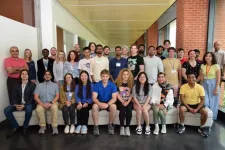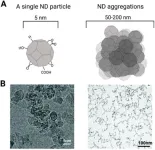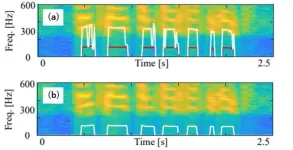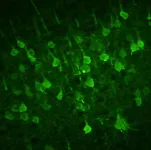(Press-News.org) A new study highlights the potential of artificial DNA structures that, when fitted with antibodies, instruct the immune system to specifically target cancerous cells.
Immunotherapy is viewed as an exceptionally promising weapon in the fight against cancer. In essence, the aim is to activate the body’s immune system in such a way that it identifies and destroys malignant cells. However, the destruction must be as effective and specific as possible, to avoid damaging healthy cells. A team of researchers from LMU, the Technical University of Munich (TUM) and Helmholtz Munich have now published a new study in Nature Nanotechnology in which they present a promising method for developing user-defined agents that can do precisely that. “The centerpiece is a tiny chassis of folded DNA strands that can be specifically fitted with any antibodies,” explains Professor Sebastian Kobold, one of the main authors. At Munich University Hospital, his team has investigated the impact of the new substrates both in vitro and in vivo.
Using DNA origami to recruit T-cells
These novel class of agents, coined programmable T-cell engagers (PTEs) are created with DNA origami, a nanotechnology in which self-folding DNA strands assemble themselves into a structure simulated in advance on the computer. Their design allows different antibodies to be attached in four positions. Antibodies that specifically bind to certain tumor cells are added on the one side, while antibodies that are recognized by the immune system’s T-cells are mounted on the other. T-cells then destroy the marked cells. “This approach permits us to produce all kinds of different PTEs and adapt them for optimized effects,” says Dr. Adrian Gottschlich, one of the study’s lead authors. “Infinite combinations are in theory possible, making PTE a highly promising platform for treating cancer.” The scientists produced 105 different combinations of antibodies for the study, testing them in vitro to see how specifically they attached themselves to the target cells and how successful they were at recruiting T-cells. The combinations could be generated in a modular way and without the previous very time-consuming optimization of the antibodies. They were able to prove that more than 90 percent of the cancer cells had been destroyed after 24 hours. To find out whether this also worked in living organisms, Professor Kobold and his colleagues examined whether PTEs also recognize and induce the destruction of cancer cells in tumor-bearing organisms. “We were able to prove that our PTEs made from DNA origami structures also work in vivo,” Gottschlich affirms.
Versatile and user-defined
Gottschlich explains that, thanks to the possibility of mounting different antibodies at the same time, tumor cells can be targeted much more precisely. It is also easier to control activation of the immune system. This increases the prospects of successfully treating cancer, by distinguishing more accurately between diseased and healthy cells and thus minimizing side effects. In light of the DNA origami technologies’ modular nature, adaptability and high degree of addressability, the researchers expect that a broad spectrum of complex and even logic-controlled immunotherapy platforms can be developed. TUM scientists Dr. Klaus Wagenbauer, Dr. Benjamin Kick, Dr. Jonas Funke and Professor Hendrik Dietz all number among the founders of Plectonic Biotech GmbH that wants to further develop and market the technology underpinning PTEs. Sebastian Kobold is confident: “We believe that our findings will permit the clinical testing of DNA nanotechnologies and demonstrate the potential of biomolecular, DNA-origami-based engineering strategies for medical applications.”
END
Immunotherapy: Antibody kit to fight tumors
2023-08-18
ELSE PRESS RELEASES FROM THIS DATE:
Auburn University hosts the 60th edition of the Renowned Computational Biophysics Workshop
2023-08-18
AUBURN, AL – In July, as many enjoyed the hot weather at Alabama's gulf coast beaches, in the Leach Science Center, Auburn University's Department of Physics hosted an engaging scientific event. For the first time since 2016, the southern USA was home to the “Hands-On Workshop on Computational Biophysics” with Auburn University, for the first time, as its esteemed host.
Under the guidance of Prof. Rafael Bernardi from Auburn University's Department of Physics and Prof. Emad Tajkhorshid of the Beckman Institute at the University of Illinois at Urbana-Champaign, the workshop showcased expertise from ...
Reviewing MAFLD opens new treatment pathways
2023-08-18
Non-alcoholic fatty liver disease (NAFLD) is a common condition that affects up to 30% of adults in the general population. It is characterized by the accumulation of fat in the liver. It is often associated with other conditions, such as obesity, type 2 diabetes, and metabolic syndrome. The new definition of metabolic dysfunction-associated fatty liver disease (MAFLD) was proposed in 2020. MAFLD is diagnosed based on hepatic steatosis (fatty liver) and at least one of three metabolic risk abnormalities: overweight/obesity, type 2 diabetes, or evidence of metabolic dysregulation.
A recent meta-analysis led by Ming-Hua Zheng from the First Affiliated Hospital ...
Looking at the latest in Life Sciences Discovery and Technology
2023-08-18
Oak Brook, IL – The August 2023 issue of SLAS Technology, the open access journal emphasizing scientific and technical advances across the life sciences, is now available. Volume 28, Issue 4, contains a review from the literature and eight full-length articles covering nanodiamonds, automated buffer exchange, epidermal growth factor (EGF) and other laboratory automation-related research.
From the Literature
Life sciences discovery and technology highlights
The authors examine several areas of research within the literature to highlight significant developments ...
A simple mouth rinse could spot early heart disease risk
2023-08-18
What if we could identify the earliest warning signs of cardiovascular disease from a simple saliva sample? Scientists think they have found a way to do so. Gum inflammation leads to periodontitis, which is linked with cardiovascular disease. The team used a simple oral rinse to see if levels of white blood cells — an indicator of gum inflammation — in the saliva of healthy adults could be linked to warning signs for cardiovascular disease. They found that high levels correlated with compromised flow-mediated dilation, an early indicator of poor arterial health.
“Even in young healthy adults, low levels of oral inflammatory load may have an impact on cardiovascular ...
Texas A&M study finds secondhand smoke may be source of lead exposure in children
2023-08-18
Lead exposure has long been a known health risk, especially for young children. Research has found that even at low levels, chronic exposure to lead can cause damage to the brain and other organs and cause problems with cognitive and motor skills. In response, public health officials have determined that there is no safe exposure level and have made great efforts to eliminate lead-based paint and lead pipes in homes and phase out the use of leaded gasoline.
But another possible source of lead exposure in children has been largely overlooked: secondhand ...
Researchers to explore 3D printing medication tailored to pediatric patients
2023-08-18
Researchers at Texas A&M University will spearhead a groundbreaking project to revolutionize medication administration for pediatric patients, thanks to an approximately $3 million grant from the National Institutes of Health (NIH).
This pioneering initiative explores using additive manufacturing, or 3D printing, to create customized tablets tailored to the unique needs of young children. The project is an interdisciplinary collaboration of experts from the College of Engineering, the College of Pharmacy and the School of Veterinary Medicine and Biomedical Sciences.
Traditional manufacturing methods yield mass-produced medicinal tablets ...
Diagnosis of voice condition from call audio
2023-08-18
Overview
Assistant Professor Yuya Hosoda of the Center for IT-Based Education (CITE), Toyohashi University of Technology developed a method for estimating the pitch of vocal cord vibrations of humans from call audio. In this method, the pitch is estimated by integrating the feature quantities extracted from the amplitude and phase spectra of speech on the complex plane. Through experiments, we have demonstrated that the proposed method is not only efficient for call audios whose frequency band is restricted by communication standards, but also works robustly in an environment with background ...
New insights into the protein-mediated motor neuron loss in amyotrophic lateral sclerosis
2023-08-18
Niigata, Japan – our movements are controlled by multiple neural pathways that connect the brain and spinal cord. In particular, neurons in the cerebral cortex send commands to the motor neurons in the spinal cord and then to the muscles, thus eliciting the required movement. However, this flow of neural information is compromised in amyotrophic lateral sclerosis (ALS)—a widespread progressive neurodegenerative disease in which the muscles gradually atrophy, making movement and breathing difficult. Moreover, a protein called TDP-43 has been found to abnormally ...
Invasive orange pore fungus wins third BMC Ecology and Evolution image competition
2023-08-18
A striking image of the invasive orange pore fungus (Favolaschia calocera), which highlights the potential threats the species may pose to Australian ecosystems, has won the third BMC Ecology and Evolution image competition. The competition showcases the wonder of the natural world — both past and present — and celebrates those working to understand it. The winning images are open access and freely available for use under a Creative Commons Attribution 4.0 (CCBY) license.
The overall winning image depicts bright ...
Scientists zero in on timing, causes of ice age mammal extinctions in southern California
2023-08-18
The end of the last Ice Age also marked the end for more than three dozen genera of large mammals in North America, from mammoths and mastodons to bison and saber-toothed cats. Details concerning the precise timing and circumstances, however, have remained murky ever since.
A team of scientists that included Texas A&M University archaeologist Dr. Michael Waters recently focused on the well-known Rancho La Brea Tar Pits in southern California in their quest to provide answers to these questions, resulting in the most exact and detailed timeline for the extinctions that happened during the latter part of the Pleistocene ...



